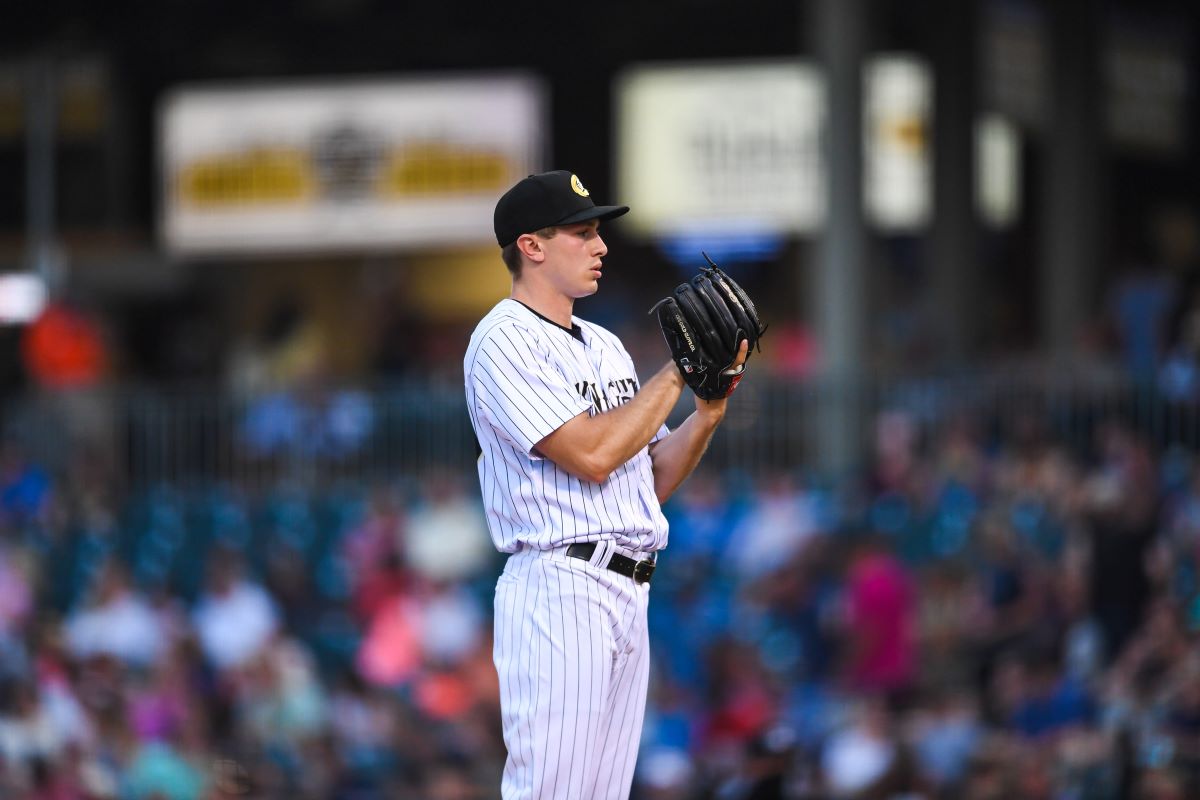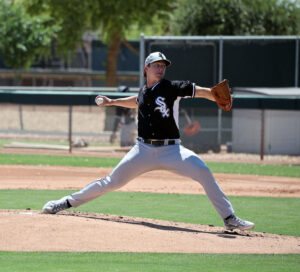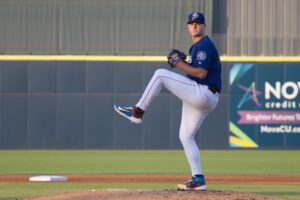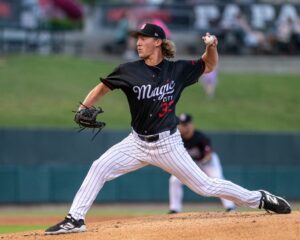Season in review: Who plays for Knights down the stretch

via Laura Wolff/Charlotte Knights
With the Knights on the road for two weeks, our beat reporter in Charlotte, Jeff Cohen, has had a chance to step back and look at the season to date. Here’s his analysis, in a three-part series. Part I examined the call-ups to date and Part II looked at the rest of the roster. Today, he tells us what to expect the rest of the season and looks back at the crazy challenges of the 2021 season.
There are 47 games left in the Knights’ season. These players are likely to get the bulk of the at bats — until September call-ups:
Danny Mendick, SS, 2B, RF
Jake Burger, 3B, 2B
Yermin Mercedes, C, DH, 1B
Marco Hernandez or Matt Reynolds, 2B
Blake Rutherford, CF
Gavin Sheets, 1B, RF
Micker Adolfo, LF
Deivy Grullon, C
One caveat: Jake Burger is currently on the IL. The team is extremely cautious with his health, giving him plenty of rest and sitting him whenever he has any discomfort. Burger has not played regularly for three years. It may take almost that long to get his body conditioned to do so again.
Also, Luis Gonzalez was released this week to create a 40-man roster spot for Luis Robert. The team hopes to re-sign Gonzalez, who is recovering from surgery and out for the season.
Of course, with Burger, Mercedes and Sheets back in Charlotte, and healthy, this could be the most potent offense of the season. When Mendick starts at shortstop, it also has the trappings of an improved defense. There are a lot of variables, but this could be some of the most competitive baseball of the season for the Knights. And after all the one-sided games, it would be a refreshing change.
A Lot At Stake In August
This is also a crucial stretch for many players. Several have their eye on September call-ups and a bench role with the White Sox. Burger, Sheets and Mendick are locks. But Mercedes would like to hit his way back to Chicago, while other long shots like Marco Hernandez and Mikie Mahtook would no doubt like to make a late push and secure a spot as well.
Jimmy Lambert also is at the top of the list for spot starts for the White Sox. But there is a fierce competition among Zack Burdi, Ryan Burr, Kyle Crick, Matt Foster, Jace Fry and Nik Turley for a bullpen role in Chicago down the stretch.
Not everyone is playing for a call-up, some are just hoping to impress the White Sox or other clubs enough to get a look in 2022. Micker Adolfo and Blake Rutherford are at the top of this list, along with several pitchers.
A Look Back At Changes Brought On By Covid
Everyone knew this year would be a different kind of season, and for the first two months of the season, the Knights were in survival mode.
Hardly anyone on their roster played organized baseball last year: pitchers’ mechanics were off, hitters’ struggled with their timing and fundamentals were rusty. So the team had to start at square one, concentrating on simply getting guys at bats and innings. Results didn’t matter.
It was especially painful for the pitching staff. Starters had highly restrictive pitch counts and often were not going more than an inning or two each outing. That triggered a stream of relievers, most of whom had poor command and were beaten up pretty good. The result was a lot of games that were barely watchable.
It has only been in the last few weeks that the roster in general and bullpen in particular have finally been sorted out. And the quality of play has improved.
Minor-league rosters also were expanded this season, because of Covid and the lack of a season in 2020, increasing the challenge of getting everyone enough playing time. But it did serve to provide depth so that players could receive more days off than normal as their bodies struggled to get in game shape after two years away from competition.
A Quirky Schedule
Minor-league baseball adopted a new schedule to minimize travel in the age of Covid. Mondays were travel days, after which teams played six-game series, Tuesday through Sunday.
Opponents were restricted to those closest to each other geographically. So the Knights will end up playing 90 of their original 120-game season against just three opponents, the Norfolk Tides (Orioles), Durham Bulls (Rays) and Jacksonville Jumbo Shrimp (Marlins). The Knights’ also have three series against the Gwinnett Stripers and two versus the Nashville Sounds.
Probably in an attempt to recover lost revenue from the cancellation of games in April and capacity restrictions in May, MLB recently added 10 more games to the end of the MILB season: five more against the Tides and five against the Memphis Redbirds (Cardinals).
Other than the Tides, the Knights’ opponents are among the better teams in Triple-A, so the schedule is often unrelenting at times. In particular, the Knights are facing an abundance of pitchers with major-league skills and experience.
While the players enjoy less travel, especially long bus rides, the monotony and familiarity of playing the same opponents adds other frustrations and challenges. One of the biggest issues is teams with five-man rotations have a starter who faces the same line-up twice in one week.
The Ballpark
It is by no means a new challenge, but it remains a perplexing one: pitchers are scared and hitters are homer-happy in the extremely hitter-friendly ballpark in Charlotte.
“I think this ballpark can hurt you as a hitter,” manager Wes Helms said. “One of the best things about our organization is when guys come through Birmingham. It is so hard to hit homers in the Southern League and in Birmingham.”
The Knights are near the league lead in home runs and slugging percentage, but also are tops in strikeouts and near the bottom in walks. But Helms said that aggressiveness is not the philosophy he is trying to impart, nor that of the White Sox.
“We want guys to grind with two strikes,” he said. “We want guys to think lower launch angle and if you catch it right it goes out of the park. Guys know they can hit it out here and they maybe try to hit it in the air too much and when you do that, you’re going to swing and miss a lot. You are going to miss pitches that you probably should barrel.”
“We want guys to do what plays in the game to win,” he continued, “and what Tony LaRussa is going to ask you to do. He’s not to ask you to hit a homer. He’s going to ask you to move a runner, he’s going to ask you get a guy in from third with less than two outs. Those are things he preaches. We want these guys to buy in here. It’s a struggle.”
It is a similar challenge for pitching coach Matt Zaleski. Over and over, he preached a strategy of being aggressive, especially on the lead-off hitter, trusting your stuff and pitching to soft contact.
But his staff had other ideas initially. They were intimidated by the way the ball carries in Charlotte, their command suffered from a year without baseball and they knew they were just one phone call away from Chicago. So they cautiously nibbled around the plate — and were awful. There were a lot of walks and a lot of three-run homers.
“I get where their heads are at because this ballpark does play small,” Zaleski said. “I have to believe that Charlotte leads the minor leagues in home runs every year. So you kind of fear contact at times.”
A few weeks ago, that finally began to change. Zaleski said it was a combination of watching veterans like Mike Wright and Jace Fry be successful in Charlotte and guys simply getting enough innings under their belt. The number of walks dropped and the results improved.
Photo credit: Laura Wolff, Charlotte Knights
Want to know right away when we publish a new article? Type your email address in the box on the right-side bar (or at the bottom on a mobile device) and click create subscription. Our list is completely spam free and you can opt out at any time. Also, consider supporting FutureSox on Patreon! You can get early access to special articles and Patreon-only posts, in addition to more benefits.
Shop our exclusive merchandise! Show your support with FutureSox apparel.







